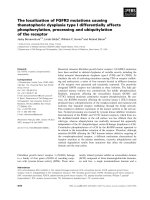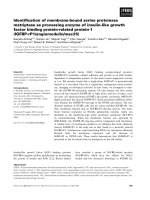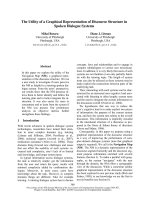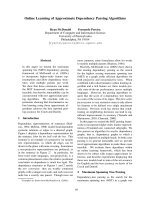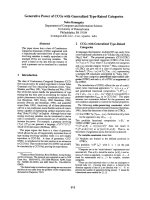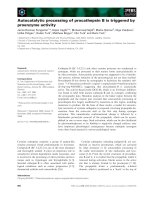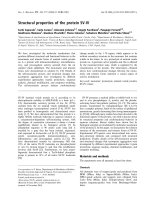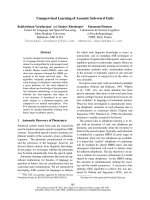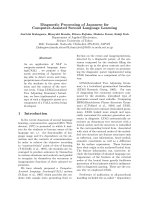Báo cáo khoa học: "Discourse Processing of Dialogues with Multiple Threads" pot
Bạn đang xem bản rút gọn của tài liệu. Xem và tải ngay bản đầy đủ của tài liệu tại đây (708.44 KB, 8 trang )
Discourse Processing of Dialogues with Multiple Threads
Carolyn Penstein Ros~ t, Barbara Di Eugenio t, Lori S. Levin t,
Carol Van Ess-Dykema t
t Computational Linguistics Program
Carnegie Mellon University
Pittsburgh, PA, 15213
{cprose, dieugeni}@icl, cmu. edu
Isl©cs. cmu. edu
* Department of Defense
Mail stop: R525
9800 Savage Road
Ft. George G. Meade, MD 20755-6000
cj vanes©afterlife, ncsc. mil
Abstract
In this paper we will present our ongoing
work on a plan-based discourse processor
developed in the context of the Enthusiast
Spanish to English translation system as
part of the JANUS multi-lingual speech-to-
speech translation system. We will demon-
strate that theories of discourse which pos-
tulate a strict tree structure of discourse
on either the intentional or attentional
level are not totally adequate for handling
spontaneous dialogues. We will present
our extension to this approach along with
its implementation in our plan-based dis-
course processor. We will demonstrate that
the implementation of our approach out-
performs an implementation based on the
strict tree structure approach.
1 Introduction
In this paper we will present our ongoing work on a
plan-based discourse processor developed in the con-
text of the Enthusiast Spanish to English translation
system (Suhm et al. 1994) as part of the JANUS
multi-lingual speech-to-speech translation system.
The focus of the work reported here has been to draw
upon techniques developed recently in the compu-
tational discourse processing community (Lambert
1994; Lambert 1993; Hinkelman 1990), developing a
discourse processor flexible enough to cover a large
corpus of spontaneous dialogues in which two speak-
ers attempt to schedule a meeting.
There are two main contributions of the work we
will discuss in this paper. From a theoretical stand-
point, we will demonstrate that theories which pos-
tulate a strict tree structure of discourse (henceforth,
Tree Structure Theory, or TST) on either the inten-
tional level or the attentional level (Grosz and Sidner
1986) are not totally adequate for covering sponta-
neous dialogues, particularly negotiation dialogues
which are composed of multiple threads. These
are negotiation dialogues in which multiple propo-
sitions are negotiated in parallel. We will discuss
our proposea extension to TST which handles these
structures in a perspicuous manner. From a prac-
tical standpoint, our second contribution will be a
description of our implemented discourse processor
which makes use of this extension of TST, taking as
input the imperfect result of parsing these sponta-
neous dialogues.
We will also present a comparison of the perfor-
mance of two versions of our discourse processor,
one based on strict TST, and one with our extended
version of TST, demonstrating that our extension
of TST yields an improvement in performance on
spontaneous scheduling dialogues.
A strength of our discourse processor is that
because it was designed to take a language-
independent meaning representation (interlingua) as
its input, it runs without modification on either En-
glish or Spanish input. Development of our dis-
course processor was based on a corpus of 20 spon-
taneous Spanish scheduling dialogues containing a
total of 630 sentences. Although development and
initial testing of the discourse processor was done
with Spanish dialogues, the theoretical work on the
model as well as the evaluation presented in this pa-
per was done with spontaneous English dialogues.
In section 2, we will argue that our proposed ex-
tension to Standard TST is necessary for making
correct predictions about patterns of referring ex-
pressions found in dialogues where multiple alter-
natives are argued in parallel. In section 3 we will
present our implementation of Extended TST. Fi-
nally, in section 4 we will present an evaluation
of the performance of our discourse processor with
Extended TST compared to its performance using
Standard TST.
2 Discourse Structure
Our discourse model is based on an analysis of nat-
urally occurring scheduling dialogues. Figures 1 and
2 contain examples which are adapted from natu-
rally occurring scheduling dialogues. These exam-
ples contain the sorts of phenomena we have found
in our corpus but have been been simplified for the
31
(1)
(2)
(3) $2:
(4)
(5) SI:
(6)
(7)
(8)
(9) $2:
(lO)
(11)
(12)
(13)
(14)
(15)
(16)
(17)
(18)
Figure
S 1: We need to set up a schedule for the meeting.
How does your schedule look for next week?
Well, Monday and Tuesday both mornings are good.
Wednesday afternoon is good also.
It looks like it will have to be Thursday then.
Or Friday would also possibly work.
Do you have time between twelve and two on Thursday?
Or do you think sometime Friday afternoon you could meet?
No.
Thursday I have a class.
And Friday is really tight for me.
How is the next week?
If all else fails there is always video conferencing.
S 1: Monday, Tuesday, and Wednesday I am out of town.
But Thursday and Friday are both good.
How about Thursday at twelve?
$2: Sounds good.
See you then.
1: Example of Deliberating Over A Meeting Time
purpose of making our argument easy to follow. No-
tice that in both of these examples, the speakers
negotiate over multiple alternatives in parallel.
We challenge an assumption underlying the best
known theories of discourse structure (Grosz and
Sidner 1986; Scha and Polanyi 1988; Polanyi 1988;
Mann and Thompson 1986), namely that discourse
has a recursive, tree-like structure. Webber (1991)
points out that Attentional State i is modeled equiv-
alently as a stack, as in Grosz and Sidner's approach,
or by constraining the current discourse segment to
attach on the rightmost frontier of the discourse
structure, as in Polanyi and Scha's approach. This
is because attaching a leaf node corresponds to push-
ing a new element on the stack; adjoining a node Di
to a node Dj corresponds to popping all the stack
elements through the one corresponding to Dj and
pushing Di on the stack. Grosz and Sider (1986),
and more recently Lochbaum (1994), do not for-
mally constrain their intentional structure to a strict
tree structure, but they effectively impose this lim-
itation in cases where an anaphoric link must be
made between an expression inside of the current
discourse segment and an entity evoked in a different
1Attentional State is the representation which is used
for computing which discourse entities are most salient.
segment. If the expression can only refer to an entity
on the stack, then the discourse segment purpose 2
of the current discourse segment must be attached
to the rightmost frontier of the intentional structure.
Otherwise the entity which the expression refers to
would have already been popped from the stack by
the time the reference would need to be resolved.
We develop our theory of discourse structure in
the spirit of (Grosz and Sidner 1986) which has
played an influential role in the analysis of discourse
entity saliency and in the development of dialogue
processing systems. Before we make our argument,
we will argue for our approach to discourse segmen-
tation. In a recent extension to Grosz and Sidner's
original theory, described in (Lochbaum 1994), each
discourse segment purpose corresponds to a partial
or full shared plan 3 (Grosz and Kraus 1993). These
discourse segment purposes are expressed in terms
of the two intention operators described in (Grosz
and Kraus 1993), namely Int. To which represents
an agent's intention to perform some action and
2A discourse segment purpose denotes the goal which
the speaker(s) attempt to accomplish in engaging in the
associated segment of talk.
3A Shared Plan is a plan which a group of two or
more participants intend to accomplish together.
32
Sl:
S2:
SI:
DS 0
1. When can you meet next week? SI:
DS 1
2. Tuesday afternoon looks good. S2:
DS2
3. I could do it Wednesday morning too.
DS 3
4. Tuesday I have a class from 12:00-1:30. Sl:
. DS 4
5.
But the other day
sounds good.
DSA
1. When can you
meet next
week?
r
DSB
!
' 2. Tuesday afternoon looks good.
!
i DS
C
!
3. I could do it Wednesday morning too.
DS D
~
, 4. Tuesday I have aclass from 12:00-1:30.
DSE
i 5.
But the other day
sounds good.
Simple Stack based Structure Proposed Structure
Figure 2: Sample Analysis
Int. That which represents an agent's intention that
some proposition hold. Potential intentions are used
to account for an agent's process of weighing differ-
ent means for accomplishing an action he is com-
mitted to performing (Bratman, Israel, & Pollack
1988). These potential intentions, Pot.Int. To and
Pot.Int. That, are not discourse segment purposes in
Lochbaum's theory since they cannot form the ba-
sis for a shared plan having not been decided upon
yet and being associated with only one agent. It is
not until they have been decided upon that they be-
come Int. To's and Int. That's which can then become
discourse segment purposes. We argue that poten-
tial intentions must be able to be discourse segment
purposes.
Potential intentions are expressed within portions
of dialogues where speakers negotiate over how to
accomplish a task which they are committed to com-
pleting together. For example, deliberation over
how to accomplish a shared plan can be repre-
sented as an expression of multiple Pot.Int. To's and
Pot.Int. That's, each corresponding to different alter-
natives. As we understand Lochbaum's theory, for
each factor distinguishing these alternatives, the po-
tential intentions are all discussed inside of a single
discourse segment whose purpose is to explore the
options so that the decision can be made.
The stipulation that Int. To's and Int. That's can
be discourse segment purposes but Pot.Int. To's and
Pot.Int. That's cannot has a major impact on the
analysis of scheduling dialogues such as the one in
Figure 1 since the majority of the exchanges in
scheduling dialogues are devoted to deliberating over
which date and at which time to schedule a meet-
ing. This would seem to leave all of the delibera-
tion over meeting times within a single monolithic
discourse segment, leaving the vast majority of the
dialogue with no segmentation. As a result, we are
left with the question of how to account for shifts
in focus which seem to occur within the deliberation
segment as evidenced by the types of pronominal ref-
erences which occur within it. For example, in the
dialogue presented in Figure 1, how would it be pos-
sible to account for the differences in interpretation
of "Monday" and "Tuesday" in (3) with "Monday"
and "Tuesday" in (14)? It cannot simply be a matter
of immediate focus since the week is never mentioned
in (13). And there are no semantic clues in the sen-
tences themselves to let the hearer know which week
is intended. Either there is some sort of structure in
this segment more fine grained than would be ob-
tained if Pot.Int. To's and Pot.Int. That's cannot be
discourse segment purposes, or another mechanism
must be proposed to account for the shift in focus
which occurs within the single segment. We argue
that rather than propose an additional mechanism,
it is more perspicuous to lift the restriction that
Pot.Int. To's and Pot.Int. That's cannot be discourse
segment purposes. In our approach a separate dis-
course segment is allocated for every potential plan
discussed in the dialogue, one corresponding to each
parallel potential intention expressed.
Assuming that potential intentions form the ba-
sis for discourse segment purposes just as intentions
33
do, we present two alternative analyses for an ex-
ample dialogue in Figure 2. The one on the left
is the one which would be obtained if Attentional
State were modeled as a stack. It has two shortcom-
ings. The first is that the suggestion for meeting on
Wednesday in DS 2 is treated like an interruption.
Its focus space is pushed onto the stack and then
popped off when the focus space for the response
to the suggestion for Tuesday in DS 3 is pushed 4.
Clearly, this suggestion is not an interruption how-
ever. Furthermore, since the focus space for DS 2 is
popped off when the focus space for DS 4 is pushed
on, 'Wednesday is nowhere on the focus stack when
"the other day", from sentence 5, must be resolved.
The only time expression on the focus stack at that
point would be "next week". But clearly this ex-
pression refers to Wednesday. So the other problem
is that it makes it impossible to resolve anaphoric
referring expressions adequately in the case where
there are multiple threads, as in the case of parallel
suggestions negotiated at once.
We approach this problem by modeling Atten-
tional State as a graph structured stack rather than
as a simple stack. A graph structured stack is a
stack which can have multiple top elements at any
point. Because it is possible to maintain more than
one top element, it is possible to separate multiple
threads in discourse by allowing the stack to branch
out, keeping one branch for each thread, with the
one most recently referred to more strongly in fo-
cus than the others. The analysis on the right hand
side of Figure 2 shows the two branches in different
patterns. In this case, it is possible to resolve the
reference for "the other day" since it would still be
on the stack when the reference would need to be
resolved. Implications of this model of Attentional
State are explored more fully in (Rosd 1995).
3 Discourse Processing
We evaluated the effectiveness of our theory of dis-
course structure in the context of our implemented
discourse processor which is part of the Enthusiast
Speech translation system. Traditionally machine
translation systems have processed sentences in iso-
lation. Recently, however, beginning with work at
ATR, there has been an interest in making use of dis-
course information in machine translation. In (Iida
and Arita 1990; Kogura et al. 1990), researchers
at ATR advocate an approach to machine transla-
tion called illocutionary act based translation, argu-
ing that equivalent sentence forms do not necessar-
ily carry the same illocutionary force between lan-
guages. Our implementation is described more fully
in (Rosd 1994). See Figure 4 for the discourse rep-
4Alternatively, DS 2 could not be treated like an in-
terruption, in which case DS 1 would be popped before
DS 2 would be pushed. The result would be the same.
DS 2 would be popped before DS 3 would be pushed.
((when
((frame *simple-time)
(day-of-week wednesday)
(time-of-day morning)))
(a-speech-act
(*multiple* *suggest *accept))
(who
((frame *i)))
(frame *free)
(sentence-type *state)))
Sentence: I could do it Wednesday morning too.
Figure 3: Sample Interlingua Representation
with Possible Speech Acts Noted
resentation our discourse processor obtains for the
example dialogue in Figure 2. Note that although a
complete tripartite structure (Lambert 1993) is com-
puted, only the discourse level is displayed here.
Development of our discourse processor was based
on a corpus of 20 spontaneous Spanish scheduling di-
alogues containing a total of 630 sentences. These
dialogues were transcribed and then parsed with the
GLR* skipping parser (Lavie and Tomita 1993). The
resulting interlingua structures (See Figure 3 for an
example) were then processed by a set of matching
rules which assigned a set of possible speech acts
based on the interlingua representation returned by
the parser similar to those described in (Hinkelman
1990). Notice that the list of possible speech acts
resulting from the pattern matching process are in-
serted in the a-speech-act slot ('a' for ambiguous).
It is the structure resulting from this pattern match-
ing process which forms the input to the discourse
processor. Our goals for the discourse processor in-
clude recognizing speech acts and resolving ellipsis
and anaphora. In this paper we focus on the task of
selecting the correct speech act.
Our discourse processor is an extension of Lam-
bert's implementation (Lambert 1994; Lambert
1993; Lambert and Carberry 1991). We have chosen
to pattern our discourse processor after Lambert's
recent work because of its relatively broad coverage
in comparison with other computational discourse
models and because of the way it represents rela-
tionships between sentences, making it possible to
recognize actions expressed over multiple sentences.
We have left out aspects of Lambert's model which
are too knowledge intensive to get the kind of cov-
erage we need. We have also extended the set of
structures recognized on the discourse level in order
to identify speech acts such as Suggest, Accept, and
Reject which are common in negotiation discourse.
There are a total of thirteen possible speech acts
which we identify with our discourse processor. See
Figure 5 for a complete list.
34
Request- Suggt
Suggestlon(S2,S 1, )
Request-
Suggestion-
Form(S1,S2, )
Argument-Segment(S2,S 1, )
Suggest- Suggest- Response(S 1,$2, )
Form(S2,S1, ) Form(S2,S1, )
/
Ask_ief(S 1,$2, ) InfoT(S2,S1, ) Infon~(S2,S 1, )
Ref-Request(S1,S2, ) Tell(S2,S1, ) Tell(S2,S1, )
I I
/
Surface- Surface- Surface-
Query- State(S2,S 1, ) State(s2,s 1, )
Ref(S 1,$2, )
Respon]e(S 1 ,$2, )
l
ReJect(S 1,$2, )
I
Accelt(S 1'$2'"')
Reject-
Accept-
Form/S1,S2, )
Fo7(S1,$2, )
/
/
Inform(S1,S2, ) Inform(S1,S2, )
J I
Tell(S 1 ,S2, ) Tell(Si 1
,$2, )
Surface- Surface-
State(S 1
,S2, )
State(S 1 ,S2, )
(1) When can
(2)
Tuesday (3) I could (4) Tuesday
Figure 4: Sample Discourse Structure
(5) But the other
It is commonly impossible to tell out of context
which speech act might be performed by some ut-
terances since without the disambiguating context
they could perform multiple speech acts. For exam-
ple, "I'm free Tuesday." could be either a Suggest
or an Accept. "Tuesday I have a class." could be a
State-Constraint or a Reject. And "So we can meet
Tuesday at 5:00." could be a Suggest or a Confirm-
Appointment. That is why it is important to con-
struct a discourse model which makes it possible to
make use of contextual information for the purpose
of disambiguating.
Some speech acts have weaker forms associated
with them in our model. Weaker and stronger
forms very roughly correspond to direct and indirect
speech acts. Because every suggestion, rejection, ac-
ceptance, or appointment confirmation is also giv-
ing information about the schedule of the speaker,
State-Constraint is considered to be a weaker form of
Suggest, Reject, Accept, and Confirm-Appointment.
Also, since every acceptance expressed as "yes" is
also an affirmative answer, Affirm is considered to
be a weaker form of Accept. Likewise Negate is con-
sidered a weaker form of Reject. This will come into
play in the next section when we discuss our evalu-
ation.
When the discourse processor computes a chain of
inference for the current input sentence, it attaches
it to the current plan tree. Where it attaches de-
termines which speech act is assigned to the input
sentence. For example, notice than in Figure 4, be-
cause sentences 4 and 5 attach as responses, they are
assigned speech acts which are responses (i.e. either
Accept or Reject). Since sentence 4 chains up to an
instantiation of the Response operator from an in-
stantiation of the Reject operator, it is assigned the
speech act Reject. Similarly, sentence 5 chains up to
an instantiation of the Response operator from an
instantiation of the Accept operator, sentence 5 is
assigned the speech act Accept. After the discourse
35
Speech Act
Opening
Closing
Suggest
Reject
Accept
State-Constraint
Confirm-Appointment
Negate
Affirm
Request-Response
Request-Suggestion
Request-Clarification
Request-Confirmation
Example
Hi, Cindy.
See you then.
Are you free on the morning
of the eighth?
Tuesday I have a class.
Thursday I'm free the whole
day.
This week looks pretty busy
for me.
So Wednesday at 3:00 then?
no.
yes.
What do you think?
What looks good for you?
What did you say about
Wednesday?
You said Monday was free?
Figure 5: Speech Acts covered by the system
processor attaches the current sentence to the plan
tree thereby selecting the correct speech act in con-
text, it inserts the correct speech act in the speech-
act slot in the interlingua structure. Some speech
acts are not recognized by attaching them to the
previous plan tree. These are speech acts such as
Suggest which are not responses to previous speech
acts. These are recognized in cases where the plan
inferencer chooses not to attach the current inference
chain to the previous plan tree.
When the chain of inference for the current sen-
tence is attached to the plan tree, not only is the
speech act selected, but the meaning representation
for the current sentence is augmented from context.
Currently we have only a limited version of this pro-
cess implemented, namely one which augments the
time expressions between previous time expressions
and current time expressions. For example, consider
the case where Tuesday, April eleventh has been sug-
gested, and then the response only makes reference
to Tuesday. When the response is attached to the
suggestion, the rest of the time expression can be
filled in.
The decision of which chain of inference to select
and where to attach the chosen chain, if anywhere, is
made by the focusing heuristic which is a version of
the one described in (Lambert 1993) which has been
modified to reflect our theory of discourse structure.
In Lambert's model, the focus stack is represented
implicitly in the rightmost frontier of the plan tree
called the active path. In order to have a focus stack
which can branch out like a graph structured stack
in this framework, we have extended Lambert's plan
operator formalism to include annotations on the ac-
tions in the body of decomposition plan operators
which indicate whether that action should appear 0
or 1 times, 0 or more times, 1 or more times, or ex-
actly 1 time. When an attachment to the active
path is attempted, a regular expression evaluator
checks to see that it is acceptable to make that at-
tachment according to the annotations in the plan
operator of which this new action would become a
child. If an action on the active path is a repeat-
ing action, rather than only the rightmost instance
being included on the active path, all adjacent in-
stances of this repeating action would be included.
For example, in Figure 4, after sentence 3, not only
is the second, rightmost suggestion in focus, along
with its corresponding inference chain, but both sug-
gestions are in focus, with the rightmost one being
slightly more accessible than the previous one. So
when the first response is processed, it can attach to
the first suggestion. And when the second response
is processed, it can be attached to the second sug-
gestion. Both suggestions remain in focus as long as
the node which immediately dominates the parallel
suggestions is on the rightmost frontier of the plan
tree. Our version of Lambert's focusing heuristic is
described in more detail in (Ros~ 1994).
4 Evaluation
The evaluation was conducted on a corpus of 8 pre-
viously unseen spontaneous English dialogues con-
taining a total of 223 sentences. Because spoken
language is imperfect to begin with, and because the
parsing process is imperfect as well, the input to the
discourse processor was far from ideal. We are en-
couraged by the promising results presented in figure
6, indicating both that it is possible to successfully
process a good measure of spontaneous dialogues in
a restricted domain with current technology, 5 and
that our extension of TST yields an improvement in
performance.
The performance of the discourse processor was
evaluated primarily on its ability to assign the cor-
rect speech act to each sentence. We are not claim-
ing that speech act recognition is the best way to
evaluate the validity of a theory of discourse, but
because speech act recognition is the main aspect of
the discourse processor which we have implemented,
and because recognizing the discourse structure is
part of the process of identifying the correct speech
act, we believe it was the best way to evaluate the
difference between the two different focusing mech-
anisms in our implementation at this time. Prior to
the evaluatic.n, the dialogues were analyzed by hand
sit should be noted that we do not claim to have
solved the problem of discourse processing of spon-
taneous dialogues. Our approach is coursely grained
and leaves much room for future development in every
respect.
36
Version Good Acceptable Incorrect
Extended TST
Standard TST
171 total
(77%)
144 based
plan-inference
on
161 total
(72%)
116 based on plan
inference
27 total
(12%)
22 based on plan
inference
33 total
(15%)
25 based on plan
inference
25 total
(11%)
20 based on plan
inference
28 total
(13%)
23 based on plan
inference
Figure 6: Performance Evaluation Results
and sentences were assigned their correct speech act
for comparison with those eventually selected by the
discourse processor. Because the speech acts for the
test dialogues were coded by one of the authors and
we do not have reliability statistics for this encoding,
we would draw the attention of the readers more to
the difference in performance between the two focus-
ing mechanisms rather than to the absolute perfor-
mance in either case.
For each sentence, if the correct speech act, or ei-
ther of two equally preferred best speech acts were
recognized, it was counted as correct. If a weaker
form of a correct speech act was recognized, it was
counted as acceptable. See the previous section for
more discussion about weaker forms of speech acts.
Note that if a stronger form is recognized when only
the weaker one is correct, it is counted as wrong.
And all other cases were counted as wrong as well,
for example recognizing a suggestion as an accep-
tance.
In each category, the number of speech acts de-
termined based on plan inference is noted. In some
cases, the discourse processor is not able to assign a
speech act based on plan inference. In these cases, it
randomly picks a speech act from the list of possible
speech acts returned from the matching rules. The
number of sentences which the discourse processor
was able to assign a speech act based on plan infer-
ence increases from 164 (74%) with Standard TST
to 186 (83%) with Extended TST. As Figure 6 indi-
cates, in many of these cases, the discourse processor
guesses correctly. It should be noted that although
the correct speech act can be identified without plan
inference in many cases, it is far better to recognize
the speech act by first recognizing the role the sen-
tence plays in the dialogue with the discourse pro-
cessor since this makes it possible for further pro-
cessing to take place, such as ellipsis and anaphora
resolution. 6
You will notice that Figure 6 indicates that the
6Ellipsis and anaphora resolution are areas for future
development.
biggest difference in terms of speech act recognition
between the two mechanisms is that Extended TST
got more correct where Standard TST got more ac-
ceptable. This is largely because of cases like the one
in Figure 4. Sentence 5 is an acceptance to the sug-
gestion made in sentence 3. With Standard TST, the
inference chain for sentence 3 would no longer be on
the active path when sentence 5 is processed. There-
fore, the inference chain for sentence 5 cannot attach
to the inference chain for sentence 3. This makes it
impossible for the discourse processor to recognize
sentence 5 as an acceptance. It will try to attach it to
the active path. Since it is a statement informing the
listener of the speaker's schedule, a possible speech
act is State-Constraint. And any State-Constraint
can attach to the active path as a confirmation be-
cause the constraints on confirmation attachments
are very weak. Since State-Constraint is weaker than
Accept, it is counted as acceptable. While this is ac-
ceptable for the purposes of speech act recognition,
and while it is better than failing completely, it is
not the correct discourse structure. If the reply, sen-
tence 5 in this example, contains an abbreviated or
anaphoric expression referring to the date and time
in question, and if the chain of inference attaches to
the wrong place on the plan tree as in this case, the
normal procedure for augmenting the shortened re-
ferring expression from context could not take place
correctly as the attachment is made.
In a separate evaluation with the same set of di-
alogues, performance in terms of attaching the cur-
rent chain of inference to the correct place in the
plan tree for the purpose of augmenting temporal
expressions from context was evaluated. The results
were consistent with what would have been expected
given the results on speech act recognition. Stan-
dard TST achieved 64.3% accuracy while Extended
TST achieved 70.4%.
While the results are less than perfect, they indi-
cate that Extended TST outperforms Standard TST
on spontaneous scheduling dialogues. In summary,
Figure 6 makes clear, with the extended version of
TST, the number of speech acts identified correctly
37
increases from 161 (72%) to 171 (77%), and the num-
ber of sentences which the discourse processor was
able to assign a speech act based on plan inference
increases from 164 (74%) to 186 (83%).
5 Conclusions and Future Directions
In this paper we have demonstrated one way in
which TST is not adequate for describing the struc-
ture of discourses with multiple threads in a per-
spicuous manner. While this study only explores
the structure of negotiation dialogues, its results
have implications for other types of discourse as
well. This study indicates that it is not a struc-
tural property of discourse that Attentional State is
constrained to exhibit stack like behavior. We in-
tend to extend this research by exploring more fully
the implications of our extension to TST in terms of
discourse focus more generally. It is clear that it will
need to be limited by a model of resource bounds of
attentional capacity (Walker 1993) in order to avoid
overgenerating.
We have also described our extension to TST in
terms of a practical application of it in our imple-
mented discourse processor. We demonstrated that
our extension to TST yields an increase in perfor-
mance in our implementation.
6 Acknowledgements
This work was made possible in part by funding from
the U.S. Department of Defense.
References
M. E. Bratman, D. J. Israel and M. E. Pollack. 1988.
Plans and resource-bounded practical reasoning.
Computational Intelligence,
3, pp 117-136.
B. J. Grosz and S. Kraus. 1993. Collaborative plans
for group activities. In
Proceedings of IJCAI-93,
pp 367-373, Chambery, Savoie, France.
B. Grosz and C. Sidner. 1986. Attention, Intentions,
and the Structure of Discourse.
Computational
Linguistics
12, 175-204.
E. A. Hinkelman. 1990.
Linguistic and Pragmatic
Constraints on Utterance Interpretation.
PhD
dissertation, University of Rochester, Department
of Computer Science. Technical Report 288.
Hitoshi Iida and Hidekazu Arita. 1990. Natural
Language Dialog Understanding on a Four-Layer
Plan Recognition Model.
Transactions of IPSJ
31:6, pp 810-821.
K. Kogura, M. Kume, and H. Iida. 1990. II-
locutionary Act Based Translation of Dialogues.
The Third International Conference on Theoreti-
cal and Methodological Issues in Machine Trans-
lation of Natural Language.
L. Lambert and S. Carberry. 1994. A Process Model
for Recognizing Communicative Acts and Model-
ing Negotiation Subdialogues. under review for
journal publication.
L. Lambert.
Recognizing Complex Discourse Acts:
A Tripartite Plan-Based Model of Dialogue.
PhD
dissertation. Tech. Rep. 93-19, Department of
Computer and Information Sciences, University of
Delaware. 1993.
L. Lambert and S. Carberry. A Tripartite, Plan
Recognition Model for Structuring Discourse.
Discourse Structure in NL Understanding and
Generation.
AAAI Fall Symposium. Nov 1991.
A. Lavie and M. Tomita. 1993. GLR* - An Effi-
cient Noise Skipping Parsing Algorithm for Con-
text Free Grammars. in the
Proceedings of the
Third International Workshop on Parsing Tech-
nologies.
Tilburg, The Netherlands.
K. E. Lochbaum. 1994.
Using Collaborative Plans
to Model the Intentional Structure of Discourse.
PhD dissertation, Harvard University. Technical
Report TR-25-94
W. C. Mann and S. A. Thompson. 1986.
Rela-
tional Propositions in Discourse.
Technical Re-
port RR-83-115. Information Sciences Institute,
Marina del Rey, CA, November.
L. Polanyi. 1988. A Formal Model of the Structure
of Discourse.
Journal of Pragmatics
12, pp 601-
638.
C. P. Ros& 1994. Plan-Based Discourse Pro-
cessor for Negotiation Dialogues. unpublished
manuscript
C. P. Ros~. 1995. The Structure of Multiple Headed
Negotiations. unpublished manuscript.
R. Scha and L. Polanyi. 1988. An Augmented Con-
text Free Grammar for Discourse.
Proceedings of
the 12th International Conference on Computa-
tional Linguistics, Budapest.
B. Suhm, L. Levin, N. Coccaro, J. Carbonell, K.
Horiguchi, R. Isotani, A. Lavie, L. Mayfield,
C. P. Ros~, C. Van Ess-Dykema, A. Waibel.
1994. Speech-language integration in multi-
lingual speech translation system, in
Working
Notes of the Workshop on Integration of Natural
Language and Speech Processing,
Paul McKevitt
(chair). AAAI-94, Seattle.
M. A. Walker.
Information Redundancy and Re-
source Bounds in Dialogue.
PhD Dissertation,
Computer and Information Science, University of
Pennsylvania.
B. L. Webber. 1991. Structure and Ostension in the
Interpretation of Discourse Deixis.
Language and
Cognitive Prvcesses,
6(2), pp 107-135.
38
